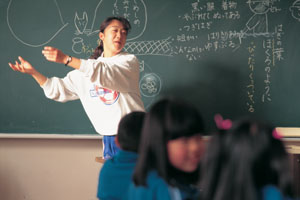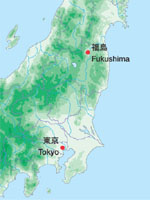Look: Spring's School Daze
Back to Contents of Issue: April 2004
|
|
|
|
by Michael E. Stanley |
|
|
During the boom years of the 80s and early 90s, there was a wave of foreign interest in and commentary about Japan's school system. Newspaper articles in this country highlighted visits by educators from Europe or North America who would invariably ooh and ah over the mathematical abilities of Japanese elementary school pupils -- and would venture comments on how this system could solve the educational crises in their home countries.
With Japan's plunge into a decade-plus of recession, the problems wrought by the Japanese system's oppressive emphasis on conformity began to emerge, as incidents of violent bullying and school truancy rose. The rote memorization in preparation for what is arguably the greatest surviving relic of the classical Chinese Confucian examination system is increasingly out of touch with the needs of a country facing a challenging future.
Lo and behold: Now the pundits at home and abroad are decrying the failure of the Japanese educational system.
As I watched and photographed, it became clear that this school in a country town was doing what it was asked to do, taking care of its business in a steady, forthright way.
Which of the two opposing images of Japanese education reflects the true situation? How much was then, and is now, manufactured "news?" And how does that, in turn, affect the reality it supposedly conveys?
@ |
|
Note: The function "email this page" is currently not supported for this page.


 In Japan, April marks the beginning of things. For the nation's youngsters and their parents, this means the start of the school year, which generally runs until the following February.
In Japan, April marks the beginning of things. For the nation's youngsters and their parents, this means the start of the school year, which generally runs until the following February.
 One fine spring day, I ventured into an elementary school class in the countryside of Fukushima Prefecture. The sweatshirt-clad teacher was animatedly reciting a story and drawing out her pupils' comments and conclusions. The fourth-graders were busy responding for the most part, but there was a light buzz of talking and snickering while some "Satoru loves Mika" notes surreptitiously passed from hand to hand. There was no harsh regimentation -- no ramrod straight spines and textbooks held at arm's length at exactly the proper angle, as in the old films and photographs. Nor was there sign of brooding sociopaths-to-be.
One fine spring day, I ventured into an elementary school class in the countryside of Fukushima Prefecture. The sweatshirt-clad teacher was animatedly reciting a story and drawing out her pupils' comments and conclusions. The fourth-graders were busy responding for the most part, but there was a light buzz of talking and snickering while some "Satoru loves Mika" notes surreptitiously passed from hand to hand. There was no harsh regimentation -- no ramrod straight spines and textbooks held at arm's length at exactly the proper angle, as in the old films and photographs. Nor was there sign of brooding sociopaths-to-be.



